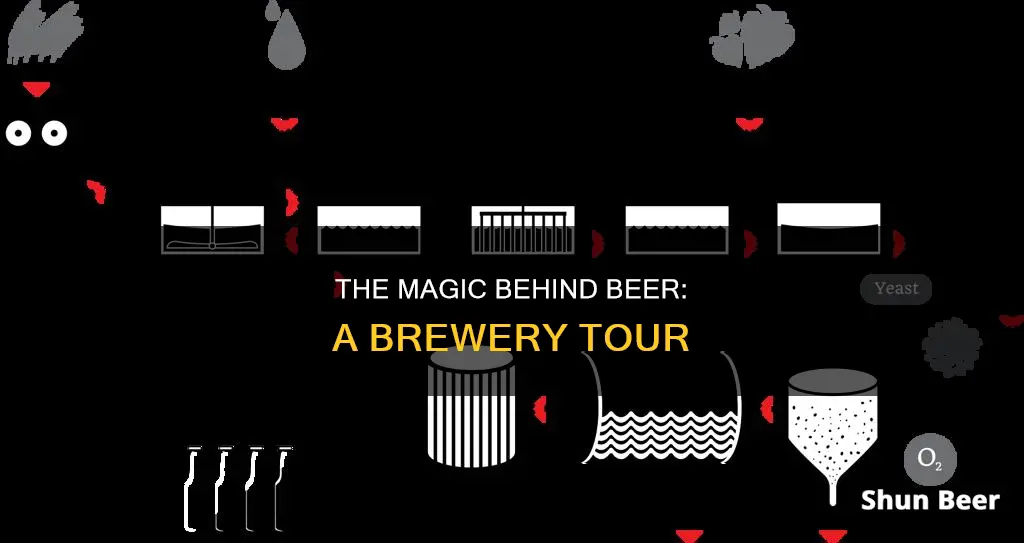
Brewing is the process of making beer, which has been done since around the 6th millennium BCE. Brewing involves a series of steps to convert barley to fermentable sugars, and to allow yeast to live and multiply, converting those sugars to alcohol. Commercial breweries use sophisticated equipment and processes to control hundreds of variables so that each batch of beer will taste the same. The basic ingredients of beer are water, a starch source (commonly barley), a brewer's yeast, and hops for flavouring. The process of brewing beer can be broken down into the following steps: malting, milling, mashing, lautering, boiling, fermenting, conditioning, filtering, and packaging.

The brewing process
The milled grain is then mixed with hot water in a large vessel known as a mash tun. This mixture is called the mash, and it is heated to temperatures between 100°F and 170°F. During this mashing process, natural enzymes in the grain break down the starches into smaller molecules, and then into fermentable sugars. This process typically takes one to two hours.
The mash is then lautered, which is a filtration process to separate the sweet liquid (now called wort) from the grain. The wort is then boiled with hops and sometimes other ingredients such as herbs or sugars. This boiling process serves to sterilize the wort, release hop flavours, and concentrate the liquid.
After boiling, the wort is rapidly cooled to a specific temperature where yeast can be added so that the process of fermentation can begin. Fermentation may be done in a variety of vessels, and it is during this stage that the sugars are converted into alcohol and carbon dioxide, and the product can officially be called beer.
After fermentation, the beer may be conditioned or aged to smooth out the flavour and dissipate unwanted by-products of fermentation. Finally, the beer is packaged by being kegged or bottled and carbonated, either naturally or by force.
How Well Does Mr. Beer Work for Beginners?
You may want to see also

Fermentation
During fermentation, yeast is added to the wort, and the sugars derived from the malt are converted into alcohol and carbon dioxide. This is the point at which the product can be called beer for the first time. Fermentation typically takes place at warm temperatures between 15 and 20°C (59 and 68°F), though it can go as high as 24°C (75°F) or as low as 10°C (50°F) for a "lager".
Most breweries today use cylindroconical vessels (CCVs) for fermentation. CCVs have a conical bottom and a cylindrical top, with the cone's aperture typically around 60-70°. This angle allows the yeast to flow smoothly towards the cone's apex, where it can be flushed out through a port at the end of fermentation. CCVs can also handle both fermenting and conditioning in the same tank. Open fermentation vessels are also used, often for wheat beer fermentation in Europe, and for show in brewpubs. These vessels have no tops, making it easy to harvest top-fermenting yeasts, but increasing the risk of infection. Fermentation tanks are typically made of stainless steel.
After fermentation, the beer is conditioned, matured, or aged. This can take anywhere from two weeks to several months or years, depending on the brewer's intentions. The beer is usually transferred to a second container so that it is no longer exposed to the dead yeast and other debris that have settled at the bottom of the primary fermenter. This prevents the formation of unwanted flavours and harmful compounds.
Beer Left Outside: Still Refreshing or a Disaster?
You may want to see also

Beer ingredients
There are four main ingredients in beer: water, grain, hops, and yeast. However, the process of brewing beer is complex and involves a series of biochemical reactions to convert these ingredients into the final product.
Water
Water is the most important ingredient in beer, accounting for over 90% of its composition. The quality of the water used can significantly impact the taste of the beer. Different sources of water have varying levels of mineral content, which can affect the flavour of the beer. For example, the high sulfate content of the water in Burton-on-Trent, England, gives the English-style pale ales made there their unique hop bite.
Grain
The grains used in beer include barley, wheat, rice, corn, oats, rye, and other cereal grains. These grains undergo a malting process, which involves germination and kilning, to prepare them for brewing. The malting process metabolises the natural grain sugars, called maltose, which the yeast will later feed on during fermentation. The method of drying the grains can also impact the colour and flavour of the malt.
The grains give beer three important qualities: malt flavour and aroma, colour, and fermentable material (sugar) for the yeast to convert into alcohol.
Hops
Hops are the flowers of a perennial vine, resembling soft, green pine cones. They add piquant aroma, flavour, and bitterness to balance the sweetness of the malt. Hops contain a yellow powder called lupulin, which contains resins and oils that are vital for beer-making. The alpha acids in hops give beer its distinctive bitterness, while the oils contribute to the floral, citrusy, hoppy aromas found in certain beer styles like pale ales.
Yeast
Yeast is a type of fungus that consumes the fermentable sugars derived from the malt and converts them into alcohol and carbon dioxide through a process called fermentation. There are two main categories of brewing yeast: ale yeast and lager yeast. Each category has hundreds of different strains, and the choice of yeast can significantly impact the character and flavour of the beer.
How Well Do Beer Thermoses Work?
You may want to see also

Beer history
Beer is one of the oldest human-produced drinks, with a history that can be traced back to ancient civilisations in Egypt, Mesopotamia, and China. In these ancient societies, beer was often considered a staple food, and it was consumed by all social classes due to its nutritional value and the fact that it was safer to drink than water.
The earliest evidence of beer-making can be found in ancient Mesopotamia (modern-day Iraq), where brewing was a well-respected occupation, often carried out by women. The oldest surviving beer recipe, dating back 3,900 years, is a Sumerian poem honouring Ninkasi, the patron goddess of brewing. This poem describes the production of beer from barley bread. Archaeological evidence also suggests that beer was produced in ancient Babylonia and Egypt, with beer stone (a by-product of the brewing process) found on pottery shards in both regions.
Beer played a significant role in the daily lives of ancient Egyptians, from pharaohs to peasants. It was considered healthier than water and was used as payment for common labour, such as the construction of the Great Pyramids. Beer was also consumed in ancient Greece and Rome, although it was less popular than wine in these regions.
During the Middle Ages, beer became a common drink, especially in northern and eastern Europe, where grape cultivation was difficult. Brewing was considered a household task, typically performed by women. Monasteries also played a crucial role in brewing during this period, as monks established breweries to provide food, drink, and shelter to travellers and pilgrims.
The introduction of hops in the 13th century by German towns marked a significant innovation in the brewing process, improving both its quality and preservation. This led to the development of larger-scale brewing operations and the export of beer. By the late Middle Ages, commercial breweries had replaced home brewing in many parts of Europe.
In the United States, prior to Prohibition in the early 20th century, there were thousands of breweries producing a variety of beer styles. However, Prohibition forced most breweries out of business, and only the largest survived. As a result, the beer industry shifted towards producing lighter lagers with mass appeal.
Today, the brewing industry is a global business, consisting of multinational companies and thousands of smaller producers, ranging from microbreweries to regional breweries. While the mass-produced lagers remain popular, there has been a resurgence of craft brewing and a growing appreciation for unique flavours and traditional brewing techniques.
Shout Stain Remover: Beer Stain Solution?
You may want to see also

Beer packaging
Preparation
The first step in packaging beer is to ensure that the containers are clean and sanitised to prevent contamination. This is done by rinsing the empty bottles or cans with filtered water or air, and then blasting them with CO2 to remove any debris or cleaning solution residue.
Carbonation
Carbonation is the process of adjusting the beer's carbonation levels to suit its style and desired taste profile. This can be done naturally through bottle conditioning, where water and sugar are added to flat beer before sealing, or artificially by injecting pressurised carbon dioxide into the beer.
Filling
The filling process involves carefully filling the sanitised containers with beer to avoid oxygen exposure and minimise foam. This step is crucial in preserving the beer's quality. The beer is pumped or poured into the containers, leaving a small amount of space at the top.
Sealing
After filling, the containers are tightly sealed to maintain carbonation and protect the beer from external factors. This can be done by applying bottle caps, using a cork and cage, or sealing kegs with a ball-lock mechanism.
Labelling
The sealed containers are then accurately labelled with essential information, including the beer type, batch number, expiration date, and sometimes a lot number indicating the date and time of bottling.
Quality Control and Distribution
Before distribution, rigorous quality control tests are performed to ensure that each batch meets the brewery's high standards for quality and taste. Finally, the packaged beer is efficiently organised and shipped to ensure that fresh, high-quality beer reaches consumers.
Packaging Options
Beer can be packaged in various ways, including kegs, cans, or bottles. Each option has its advantages and disadvantages, impacting consumer perception and product shelf life. Kegging, for example, is less common in the B2C market but is often used for selling large quantities of beer to another industry or business, as it saves space and time in packaging and transportation. Canning is a popular choice for many big breweries as it is innovative, smart, and easy to transport and store. Bottling, on the other hand, is often chosen to communicate the high quality of the beer, as glass is the traditional material for beer bottles and is hygienic, aesthetically pleasing, and natural.
Energy and Alcohol: Do Beer and Red Bull Work?
You may want to see also
Frequently asked questions
The basic ingredients used to make beer are water, a starch source (commonly barley), hops, and yeast.
The first step in the beer-making process is mashing, in which the grist (milled malt) is combined with water (also known as liquor) and heated to temperatures between 100°F and 170°F.
Lautering is the process of separating the wort (the liquid containing sugar) from the spent grain. This is typically done in a lauter tun, which has a false bottom to act as a filter.
During fermentation, yeast is added to the wort, and the fermentable sugars are converted into alcohol and carbon dioxide, resulting in beer.







